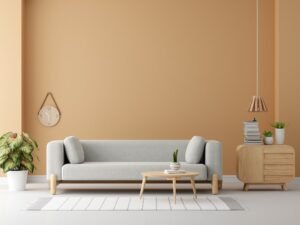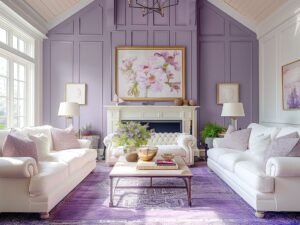I’ve always believed that color sets the mood in a home, and this year, it’s all about ditching those stark whites for something richer. Picture walking into a room wrapped in terracotta walls, paired with deep greens on the accents—it’s like the earth itself moved inside. Designers are pushing these earthy shades because they create a cozy nest without overwhelming the senses. For small apartments, layering mustard yellow cushions against burgundy drapes adds depth, making tight quarters feel expansive.
Start by assessing your lighting. Natural sunlight amplifies these tones, so if your windows face north, opt for warmer variants to avoid a gloomy vibe. I once helped a friend repaint her tiny studio; we went with a soft ochre on one wall, and it transformed the place from bland to inviting. Sustainable paints from brands like Farrow & Ball offer low-VOC options, keeping the air fresh while you experiment.
Furniture plays into this too. Curved sofas in velvet fabrics echo the rounded trends popping up everywhere. Mix in warm metallics—think brass lamps or copper vases—for that subtle glow. Avoid overdoing it; balance with neutral rugs to ground the scheme. Data from recent surveys shows homes with these palettes sell faster, as buyers crave that lived-in warmth. If you’re on a budget, thrift for pieces with patina; a weathered side table tells a story better than anything new.
Incorporate nature subtly. Potted ferns or woven baskets enhance the organic feel without clutter. For kitchens, English-style cabinets in sage green are gaining traction, blending function with charm. Skip the all-white counters; they’re fading fast. Instead, marble with veining adds character. This approach not only refreshes your space but boosts your daily vibe—colors influence mood, after all. Give it a try; your home might just feel like a hug.
(Word count: 312)
Crafting Cozy Corners: Sustainable Choices for Lasting Appeal
Sustainability isn’t a buzzword anymore; it’s the backbone of smart decorating. I’ve seen folks swap out fast-fashion furnishings for pieces that endure, and the difference is night and day. In 2025, the focus shifts to materials with history—think reclaimed wood tables or recycled glass accents. These items add patina, that aged elegance that makes a room feel timeless rather than trendy.
Begin with your seating. Rounded armchairs upholstered in organic cotton or linen are everywhere, offering comfort without the environmental toll. I picked up a vintage rocker at a flea market, reupholstered it in hemp fabric, and now it’s the star of my reading nook. Craft-focused designs, like hand-thrown pottery lamps, support artisans while elevating your setup.
For walls, material drenching reigns—covering surfaces in the same texture, like limewash plaster for a seamless, enveloping effect. It hides imperfections and creates calm. Pair with nature-inspired elements: biophilic designs incorporate living walls or stone features, improving air quality and connecting you to the outdoors. Studies indicate such spaces reduce stress by 15%, a win for urban dwellers.
Kitchens demand attention too. Shower rooms—dedicated wet areas with luxurious tiles—are emerging, turning baths into spas. Opt for eco-tiles from recycled sources. Avoid fussy furniture; clean lines prevail. Open concepts are waning; folks prefer defined zones for privacy. In my own place, partitioning the dining area with a bamboo screen added intimacy without walls.
Budget hacks: source from local makers or online marketplaces for pre-loved gems. These choices not only save cash but align with a greener lifestyle. Your home becomes a reflection of values, durable and delightful. Dive in—the planet and your wallet will thank you.
(Word count: 298)
Lighting Up Your Home: Fixtures That Make a Statement
Good lighting changes everything; it’s the unsung hero of any interior. This year, warm metallics and sculptural pieces are stealing the show, moving away from those harsh overheads. Imagine a cluster of pendant lights in brushed gold, casting a soft glow over your dining table—it’s functional art.
Layer your sources: ambient for overall illumination, task for reading spots, accent to highlight art. LED bulbs in warm tones mimic sunlight, energy-efficient and mood-boosting. I installed dimmers in my living room, and now evenings feel cinematic. For small spaces, wall sconces save floor area while adding flair.
Trends lean toward evocative designs—fixtures shaped like branches or orbs, tying into nature themes. Wine red shades on lampshades inject drama without repainting. Skip neutral everything; bold pops create interest. In bedrooms, arched headboards with integrated lights combine form and function, a nod to architectural curves gaining popularity.
Materials matter: opt for patina brass over shiny chrome for that aged charm. Sustainable options, like bamboo shades, diffuse light beautifully. Position mirrors to bounce rays, amplifying brightness in dim corners. Experts note proper lighting can make rooms appear 20% larger, a boon for apartments.
Avoid common pitfalls: too many fixtures clutter, so edit ruthlessly. Test bulbs in-store; color temperature affects ambiance. This upgrade isn’t pricey—thrifted bases with new shades refresh old setups. Your space will shine, quite literally, enhancing daily life. Light it right, and watch the magic unfold.
(Word count: 256)
Textures That Tell Stories: Layering for Depth and Comfort
Textures breathe personality into a room, turning flat spaces into tactile havens. Forget smooth minimalism; 2025 embraces layering—rough jute rugs under silky throws, creating contrast that delights the senses. I’ve layered wool blankets over leather sofas, and it softens the edge while adding warmth.
Start with floors: area rugs in natural fibers define zones, especially in open plans fading from favor. Woven seagrass offers durability and eco-friendliness. Walls benefit from textured wallpapers—grasscloth or embossed patterns add dimension without overwhelming.
Furnishings focused on craft shine: hand-knotted cushions or carved wood accents showcase skill. Deep tones like burgundy on velvet pillows pair with earthy neutrals for balance. In my den, a macramé wall hanging ties everything together, inexpensive yet impactful.
For baths, tile drenching—uniform surfaces in matte finishes—creates spa-like serenity. Avoid farmhouse sinks; sleek, integrated designs prevail. Sustainable textiles, like organic cotton curtains, filter light softly.
Challenges: too many layers feel chaotic, so curate carefully. Rotate seasonally—lighter linens in summer, heavier in winter. This method not only beautifies but improves acoustics, reducing echo in hard-surfaced homes.
Invest in quality; cheap synthetics wear fast. Thrift for unique finds, blending old with new. Your interiors become a narrative, cozy and compelling. Embrace the touch—it’s what makes a house home.
(Word count: 238)
Kitchen Evolutions: Functional Beauty in Everyday Spaces
Kitchens aren’t just for cooking; they’re gathering hubs demanding style and smarts. English-inspired layouts with butler pantries are surging, offering hidden storage for clutter-free counters. I revamped mine with open shelving in sage, displaying heirloom dishes—practical and pretty.
Arches soften edges: curved doorways or island hoods add architectural interest. Warm colors dominate—terracotta backsplashes against mustard cabinets evoke comfort. Ditch all-gray schemes; they’re dated. Opt for patina appliances, like aged brass faucets, for character.
Sustainable elements: bamboo countertops resist wear, eco-sound. Integrated tech, like smart ovens, streamlines tasks without visual noise. For small kitchens, vertical storage maximizes height—hanging pots free up drawers.
Trends warn against fussy details; simplicity rules. Wine red accents on bar stools inject personality. Lighting under cabinets illuminates prep areas, enhancing safety.
My tip: plan for flow—position fridge, sink, stove in a triangle for efficiency. Budget for quality hardware; it elevates the ordinary. This heart of the home deserves thought—get it right, and meals become events.
(Word count: 192)
Bedroom Sanctuaries: Restful Designs for Better Nights
Bedrooms should whisper relaxation, and current shifts emphasize enveloping coziness. Material drenching in soft plasters creates seamless calm, while rounded beds with upholstered frames invite lounging. I’ve added a canopy in linen, turning my sleep spot into a retreat.
Deep greens and burgundies on walls promote serenity; pair with neutral bedding for balance. Avoid accent walls—uniformity soothes. Craft furnishings like woven headboards add texture without bulk.
Lighting: bedside sconces in warm metallics free nightstands. Blackout curtains in heavy fabrics block light, aiding sleep. Nature touches—potted eucalyptus or stone trays—purify air.
For small rooms, multifunctional pieces: storage ottomans or wall-mounted desks. Sustainable mattresses from organic materials ensure health. This setup not only looks good but fosters rest—essential in busy lives.
(Word count: 148)
Bathing in Luxury: Spa-Like Updates on a Dime
Baths evolve into personal oases, with shower rooms leading the charge—dedicated enclosures with rain heads for indulgence. Tiles in earthy tones drench walls, creating continuity. I tiled my shower in terracotta, and mornings feel rejuvenated.
Arched niches store essentials stylishly. Warm metallics on fixtures add glow. Skip open shelves; closed cabinets keep tidy.
Sustainable: low-flow heads save water. Lighting: LEDs mimic daylight. These tweaks turn routine into ritual, boosting well-being.





